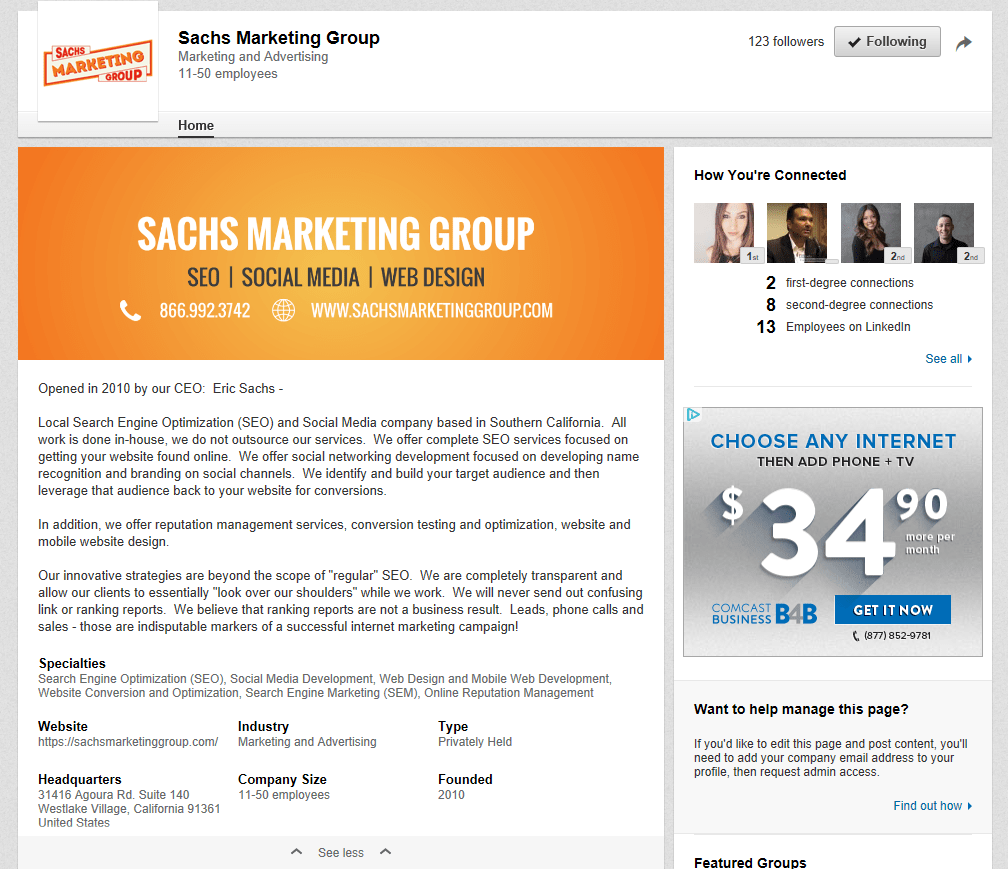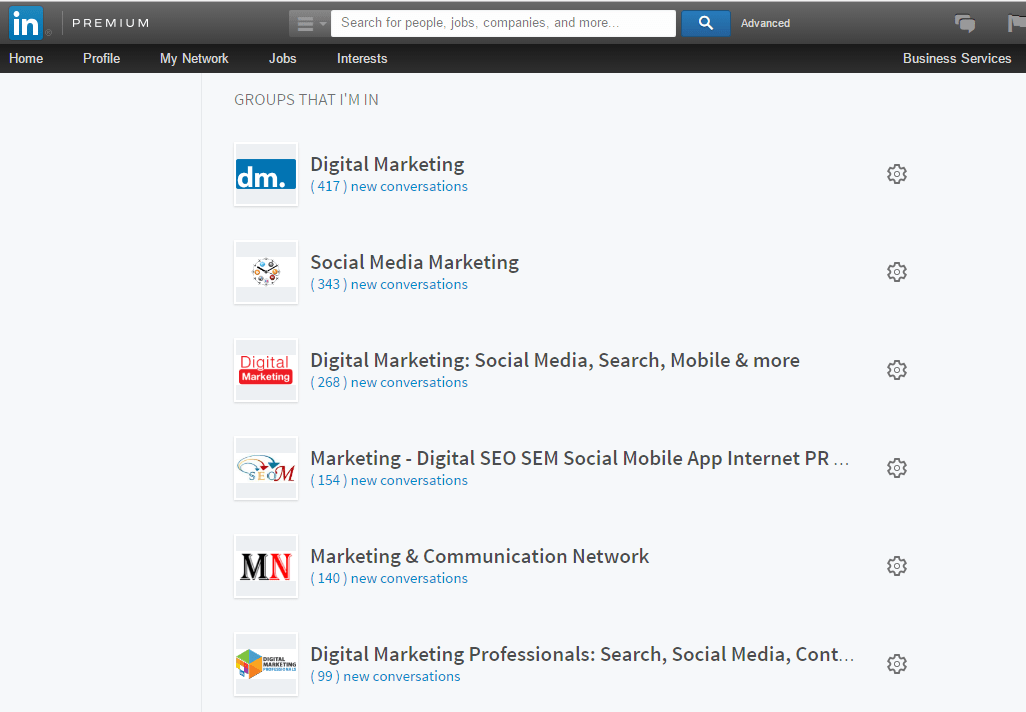Regardless of where LinkedIn falls in your company social strategy, it’s a good idea to maintain a presence there. When used correctly, it can be a powerful tool for your business, going beyond recruiting to help engage customers, share internal information with your employees, and even generate sales leads.
If you’re already using a LinkedIn strategy to promote your business, you’re one step ahead, maybe. It’s possible that you’re not using it to its fullest potential, making one or more of these mistakes.
Overview
Incomplete LinkedIn Profiles
Check your profile for completeness, and ask your employees to do the same. If there’s something missing, fill it in. Your profiles, and those of anyone who works for your company, are an extension of your brand. If left incomplete, you’re sending a message that you’re sloppy and don’t care.
Your profiles should be a representation of your brand, as well as the products and services you provide. LinkedIn does show up in Google’s search results, but beyond results for names, you’ll see them in search results for areas of expertise and skills, too.
If a potential customer or business partner sees your profile and it’s not complete, it’s reasonable for them to believe you don’t have the right networking skills, or a professional environment. And, you never know what you could be missing out on by sending that message.
Always have your profile at 100% completeness, with a photo and background art. Individual profiles should feature a headshot, or something close to a professional headshot, while your company page should have your logo. Profiles that include a photo are viewed more frequently than those that do not. In fact, having a photo on your profile makes it seven times more likely to be found in LinkedIn search results. Adding your two most recent positions makes your profile 12 times more likely to be found. And, if that’s not enough, complete profiles are 40 times more likely to receive opportunities through the platform.
If you’re not sure what your profiles are missing, there’s a tool on LinkedIn that can help walk you through everything so you can get the most of it. At the least, you need:
- Industry and location
- Current position with description
- Two past positions
- Education
- A minimum of three skills, though five is better
- A profile photo
- At least 50 connections – if you need to get started, connect your address books from Gmail and other email accounts to find people you’re already in contact with.
Profiles Built for Recruits Rather Than Prospects
This is specifically for you sales reps out there. I bet you’re excited because you know your profile is complete, and you know how to use LinkedIn… and you do it every day. But, stop reading right here, and open your profile in another tab. Look closely at it as you continue reading.
If you’re like most everyone else on LinkedIn, your profile includes your:
- Job history
- Professional achievements
- Educational background
- Endorsements from others in your network
That’s great and all – but there’s one problem with it – it’s built to advertise you to recruits… and not to prospects. As a sales person, you’re not like most people on LinkedIn, and your profile should reflect that.
You can put all kinds of impressive numbers on your profile, and if you’re looking for a job that’s where you should be going. Recruiters care about these numbers, but prospects don’t.
Your prospects only care about what you can and will do for them. Your sales numbers won’t do that. It only tells them you’re good at closing deals, which sends a vibe that you’re not helping their situation, but that you could be an untrustworthy shark who’s just in it for the numbers.
Now, because you’re not said untrustworthy shark, or at least I hope you’re not, here’s how to fix it:
Scrap your old LinkedIn content, and re-write it with a focus on how your sales numbers relate to your buyers. Tell a story about the other customers you’ve helped, your industry expertise (and in other industries, if you’re selling a product that targets any others.)
Say what you do, who you work with, and how your work helps them improve. Then, show numbers your work has helped your customers achieve.
This way, your prospects see the value in what you have to offer during a sales call – making it easier for you to show them why you and the product or service you offer is the solution they’ve been looking for.
As you re-write the content, don’t forget about keywords and optimizing your profiles for LinkedIn search.
Team Members Aren’t Networking
If your employees aren’t out there networking, you’re not expanding your reach. For each person who’s using LinkedIn to connect with others, your second degree connections outside the company have the potential to grow exponentially.
Encourage your team to connect with current and past colleagues, employers, friends, and classmates. They should also participate in relevant groups to share knowledge and expertise. New connections can come of relationships built in those groups.
It’s a good idea to monitor what your employees share on the network to follow along with company chatter. Does your company have a social media policy? If not, it’s time to create one, so everyone knows the rules they’re supposed to be playing by. If you do have a policy in place, make sure it’s adequate for LinkedIn, not just Facebook and Twitter.
Not Participating in LinkedIn Groups
LinkedIn has hundreds of thousands of groups, so no matter what industry you’re in, there’s at least one you could actively participate it. These group discussions are an often overlooked feature that could make a lot of difference in your overall social strategy.
You can find industry news and innovations, and share your expertise with others. It gives you a chance to interact with other people to build relationships, that could be highly useful to you in the future. The key is to genuinely participate, rather than spam the group with information about your company, products, and services. Reach out to other group members when possible, providing honest feedback and help when they ask for it. If someone is struggling with a problem you’ve dealt with before, offer your advice.
Beyond your industry, find groups related to your customers’ industries, and where your customers could be active.
Incomplete Company Profile
This is along the same lines of having an incomplete profile for yourself. Your company profile is a definite reflection of your brand, and should be filled out completely, with current information.
Beyond the basics, all your products and services should be featured. You want to present them so all your potential customers or clients know everything your offer. And instead of tooting your own horn, position the information to where they see how it can help them solve their problems. It’s not about you, even though it may feel that way. Make it about your prospects, and you’ll see a difference in the quality of leads you attract, and hopefully an increase in your conversion rate.
If you don’t have a company profile, go to LinkedIn right now and take care of it. I’ll be here when you get back. Not sure where to start? LinkedIn has an entire page dedicated to resources for Company Pages Best Practices to help you get started on the right foot.
Your company page should include at the very least:
- Company description
- Specialties
- Industry
- Website
Ideally, you need to optimize for search engines, so you should use highly descriptive language with appropriate keywords throughout.
To truly flesh out your LinkedIn company page, build out your products and services page. According to LinkedIn, those who build out that page have twice as many followers as those who don’t. But, your products and services page can be used for more than that – you can also use it to showcase white papers, tutorials, and case studies.
If you have a YouTube channel, you can embed customer testimonials, product demos, or a company story video, too.
Don’t forget to add a LinkedIn button to your website to make it easy for people to follow your company profile with a single click.
Inconsistent Company Information
It’s easy to end up with inconsistent company information, as you create your company profile and forget about it. Each time you bring on an employee, your company will likely be at a different stage, thus what’s current and correct at the time, may not be current and correct the next time someone comes on board. Over time, the information you have out there about your company becomes inconsistent.
While this may not seem like a big deal, prospects are researching companies more today than they have in the past – the internet makes it incredibly easy to do that. Think about the last time you were in the market for a big purchase. How much research did you do before you decided which companies to contact? Which vendors to shop through? And how much more research after you made your decision did you do before you actually made that purchase?
Even if you didn’t see any inconsistent information over the course of your research, imagine how you would have felt if you did. Which source of information is the right one? If the company can’t keep information consistent across all platforms, are they trustworthy? Do they deserve your business? Wouldn’t you skip that company and go to another one that has the same information available across the board? I would, and I bet you would, too.
If people see two sources of information about something and they conflict, chances are they aren’t going to take the time to investigate far enough to see which source is correct. If you want to sell your business to prospects, make sure the information is consistent across the company page, and all employee profiles. Revisit your LinkedIn profiles on a regular basis, especially when things change, so you can make sure everything is current and consistent across the board… even matching all your other social media profiles.
Not Searching for Connections
You should be using LinkedIn to search for connections on all levels of your business. Customers are an obvious choice, but dig deeper. Use it to find employees, suppliers, strategic partnerships, and more.
Take time every day to search for people that fit your target demographics. When you find someone that fits the bill, whatever group they fall into, look closer to see if there are any mutual connections you can use to get an invitation to connect. If you send invitations, send a personalized message, not just the generic one, that explains why you’d like to connect, and what you could bring to the table – putting the benefit to the connection ahead of your own motives. Remember, it’s not about you – it’s about them!
Making LinkedIn Work for You
If you’ve caught yourself in any of these mistakes, today’s the day to make a change. Start with your own profile, making sure it is not only complete, but also up to date with the most current and relevant information. As you check the profile for completeness, think about the message you’re sending with it. You’re not on LinkedIn to get hired – you’re on LinkedIn to make connections with prospects. If necessary, rewrite your profile content to reflect that.
Check employee profiles and make note of places where improvements could be made. Meet with your team to make sure everyone is aware of what changes should be made, and consider having a discussion about the ways you are currently using the platform, and how you intend to use it in the future to help your business grow.
What other tips and tricks do you have for making LinkedIn a success for you? Share them below, and be sure to connect with me on LinkedIn.
Photo credit: iStock
Contact us today to get the conversation started!












